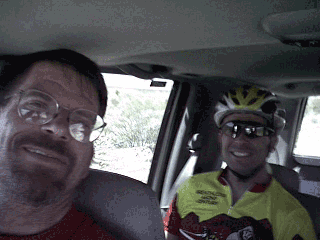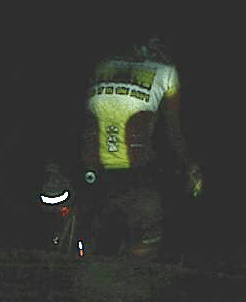On the first day of the race before dark fell we were not allowed to follow directly behind a rider. Instead a leap frog technique is used. Team Polar Bear used two support vehicles. Each vehicle had two riders and two support people. In the vehicle in which I rode, Mike was the driver.

Mike is an animal himself. He drove for 27 hours straight and managed to keep his sense of humor for all of those hours. He did get about 30 minutes of sleep or so while we waited for Doug to finish a decent at about 4:30 am, but that was about all the sleep that he got.
Each vehicle stayed with there riders. When leap frogging, you would get your rider on the road, then wait until they got half a mile or so ahead of you. Drive up the road a mile or so, pull over and wait until the rider passes by a another half a mile or so and do it again until the rider is exchanged. When the rider is exchanged you get your rider and his bicycle into the vehicle, then head for the next exchange point which is set by the rider from the other vehicle. If the terrain starts to climb or descend we may move the exchange point to generally shorten the time the rider would stay on the road. You can stretch the rider but takes care; it is really easy to tire out a rider by making them ride further than they expect as they are generally making an all out effort. When leap frogging, keeping in direct sight of the rider is very, very important. If they have a mechanical problem the support vehicle drives up to the rider and gets another rider onto the road. Then fix the problem and go pick up the rider. Most likely the rider that you just put on the road will be tired, so you cannot leave them out there long.
This happened a few times. The first time was when Tony broke a chain. We were right behind him when this happened. We had not been briefed on what to do prior to the race but we figured out very quickly that without having a rider on the road we were loosing time. We put Spike out on the road stopped and fixed the chain. Tony went back into the car and we picked up Spike at the next rider exchange. We communicated what had happened and sorted things out to get back into our regular rotation pattern. This happened again when Brian flatted. If the rider manages to get the mechanical fixed before you can get another rider on the road, great. But always keep a rider on the road.
Since Mike drove, Ken was responsible for everything else. This involved navigation, getting stuff for riders to keep them comfortable, loading and unloading bicyles, fixing things, radio communications with the over support vehicle, taking pictures, keeping records, nagging riders to eat and drink and everything else.
Riders had four jobs: to ride, to rest, to eat and to drink.
 Since rider exchanges alternated between vehicles, riders would stay on the road for 15, 20, 30 minutes or so. The other riders would get 45 minutes or more of rest. It was tough on the riders, they have make a cold start and ride with a maximum effort, then immediatly get back into the car without a spin down.
Since rider exchanges alternated between vehicles, riders would stay on the road for 15, 20, 30 minutes or so. The other riders would get 45 minutes or more of rest. It was tough on the riders, they have make a cold start and ride with a maximum effort, then immediatly get back into the car without a spin down.
Once the rider is in the car they have to eat and drink so that they can you use the time to digest and absorb sustanance. If they need to use a bush they can get a moment to do so at the next rider exchange. This is hard to do too as the rider is still all fired up from the ride. So, I nagged them about it, which worked pretty well. We did not have any dehydration problems.
At dusk of the first day, we rigged for following our riders. This involved setting up some blinking lights and a reflector on the vehicle. When following the rider the rider is kept only a few bicycle lengths in front of the vehicle, in the reach of the headlights.
 The picture is a bit misleading the rider is not this close to the vehicle. I cropped the picture so that there was something to see.
The picture is a bit misleading the rider is not this close to the vehicle. I cropped the picture so that there was something to see.
One of the highlights for me was watching Tony descend a two lane mountain road in the dark with only the light on his bicycle and our headlights to provide illumination at 45 mph. We were hoping that the road would not get any steeper as any more speed would make it difficult for our vehicle to keep up with him.
Tony would line up to go into the turn, point his knee into the turn, and carve the turn, then do it again and again.
When Tony got back into the car he told use that he could not see where he was going ! His light did not point far enough out in front of him and he was outrunning his light. So he would just line up for the turn and follow the white line, praying that something bad would not happen. Very exciting stuff. We had Tony on this decent because of his skill at these types of decents.
Another highlight was late at night. The days haze had cleared and the half moon had set. The sky was very clear, full of stars and the milky way cut a wide path across the sky. Off in the distance you could see teams on the road as the road worked its way up the mountain. I counted 14 sets of lights, each one from a car following a rider. On that climbing road team Polar Bear caught up with and passed most of the solo riders.
The most difficult moments came at 4:00 to 6:30 in the morning. We were all very tired and still had another 12 hours or so of work to do. It got much better with the coming of dawn; we all perked up quite a bit. Marriane stopped sounding like she was 7/8 ths asleep.
We were still allowed to follow our riders during the second day, which was good as it kept any traffic issues away from the riders.
![[Image]](../pictures/race/tony_or_spike_ad.png)
![[Image]](../pictures/race/tony_or_spike_ac.png)
![[Image]](../pictures/race/tony_or_spike_ab.png)
Highlights:
-
Tony descending a mountain at night.
-
Seeing teams climbing the mountain in the distance.
-
The weather. Highs were about 95. Lows were in the low 60s maybe. Winds were light. Days with hazy high clouds. Night was clear and full of many, many stars.
Things of Note:
-
It is really hard to judge distance and speed for high speed rider exchanges. These can work but are best to avoid.
-
The finishing order of the teams was set within the first 50 miles or so of the race.
-
More thought and practice with rotations and rider exchanges before the race!\
-
We underestimated our food and water needs. We had too much gatoraid and soda pop. The support staff cut down on food consumption to make sure that there would be enough for the riders. We did not actually run out of food but the support staff could have used more. Soda and gatoraid only goes so far.
So, what worked:
-
Radio communications. We used CB radios with magnetic base antennaes that we kept on the dashboard and plugged into the cigarette lighter.
-
The four man rotation worked really well, provided a fair amount of rest for everyone. If a rider took a little too long of a pull and was tired, we could switch to a three man rotation allowing the tired rider and extra stretch of rest. This did not seem to tire out the other riders too much though they would tire more quickly.
-
Two man rotations if the next rider exchange is too far away or a mechanical happened. Tony was on a descent that was about 17 miles long. The only problem was that the descent was a very shallow descent with some headwind. After a while, Tony got tired. We put Spike on the road.
-
Rider exchanges on climbs. The slower speeds made timing easier.
-
Letting the approaching vehicle call the distance on rider exchanges. They can see and judge distances best, particularly at night.
-
Clipping in before the rider exchange and using the support vehicle for support. Fumbling on pedals during a rider exchange can really eat up time.
What did not work:
-
The radios. They did not have much range. Plus you had to know how to use the squelch or you could only communicate with the other vehicle if you where right on top of it. We should have checked this out before the race.
-
Learning how to do rider exchanges in the race. We did not give up much time but we could have given up less.
Ideas for the future:
-
Binoculars. We could use a pair of these, one for each vehicle. They would make it really easy to pick out approaching riders and vehicles, particularly at night.
-
Use my van. The van is big enough for three bicycles, two support people, two riders, and ice chest, organized storage for supplies, and space to allow both riders to lie down.
-
First aid kits. Good thing we did not need one !:>
-
A sound system. Other teams had sound systems on their vehicles to communicate with their riders. This is a great idea.
-
Aero bars. We were only 15 minutes behind our nearest competition. Having aero bars and knowing how to use them could easily make up fifteen minutes.